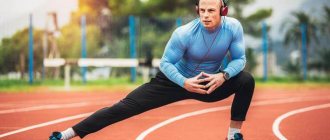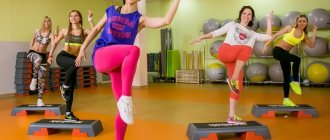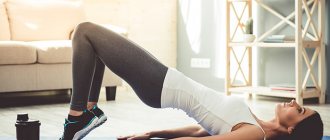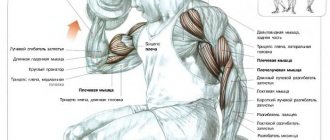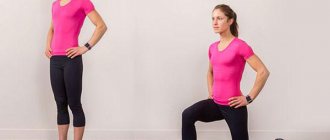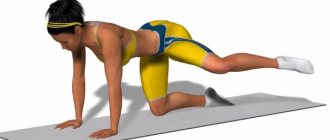Types of stretching exercises
Exercises for stretching the leg muscles can be divided into several types:
| Type of stretch | Description |
| Static | It is especially suitable for beginners, as it is gentle on the muscles. They stretch, but do not tense. Do these exercises for 15 seconds to a minute. You can train any muscle groups. |
| Dynamic | The essence is completely opposite to the static one. These movements are characterized by dynamics and active actions. Raising your arms, lunging your legs, twisting your body. |
| Passive | It differs from static in that it is performed in pairs. Here it is important to feel your body and react in time to your partner’s actions, to tell him how hard to push or pull. This stretching allows you to stretch your muscles even better and increase your range of motion. |
| Active | It is in many ways similar to dynamic, but its main difference is independent actions and working with your own weight. This stretching often acts as a complement to another type, but can also be independent. |
| Ballistic | This is a specific type and is not suitable for everyone. Unlike smooth movements, these exercises are performed rhythmically and intensely - jumping, pushing, sharply and with maximum amplitude. |
Is it possible to stretch before training?
Stretching before a workout is as important to the muscles as warm-up exercises, but without them, stretching cold muscles can be dangerous, meaning stretching can end the workout before it even begins.
Stretching exercises will prepare the muscles for loads in which the fibers will have to both contract and stretch, as well as overcome obstacles or perform various tricks. Therefore, pre-stretching will help avoid injury and improve workout performance.
You only need to stretch well-warmed muscles, spending 7-10 minutes warming up. And only after the muscles and ligaments have warmed up can they be stretched.
When to stretch your muscles: before, during exercise, after training?
Jacob Wilson, a sports physiologist at Florida State University, says stretching before exercise is important. However, this should not be a static form, you need to do a dynamic warm-up. And after classes, stretch to calm the body and bring the pulse back to normal (book “Cardio or Strength” by Alex Hutchinson).
Citing the same source, it can be noted that Jason Winchester, a scientist from Louisiana State University, is confident that you should not stretch before strength exercises . But stretching after training is a must. If such exercises are planned, it is good if enough time passes before the main strength exercises. You can also do them on non-training days, for example in the morning or before bed.
It is also a good idea to stretch the working muscles between sets of strength exercises. Not for long, literally 10-15 seconds.
Warm up before stretching
Experiments on rats at the University of Michigan showed that muscles must be warmed up before stretching, otherwise they will be severely injured. Experts advise warming up before stretching - jogging, cycling to warm up properly (book “Cardio or Strength” by Alex Hutchinson).
How and how long to stretch?
Ideally, stretching your legs should take 10-15 minutes. On average, stretching lasts about 10-20 minutes. Before it starts, you should restore your pulse.
What are the benefits of leg stretching?
In addition to the main large muscles of the legs - the muscles of the thighs (quadriceps and biceps femoris) and calves, there are also less popular muscles among most beginner athletes (biceps femoris, semitendinosus, tibialis and others). In addition to the muscles, the legs also contain tendons and joints, which are also involved in the stretching process.
The benefits of doing leg stretching exercises are that it increases muscle endurance, flexibility, develops coordination, mobility and strengthens joints. It doesn’t matter where you do the exercises: in a sports club or at home, stretching the leg muscles significantly improves blood circulation, and the stretched part of the body gradually becomes elastic.
Of course, to achieve the maximum effect of toned legs, it is necessary to carry out strength training. Afterwards, the stretching process relaxes tense muscles, which promotes better oxygenation and more active recovery.
Exercises for the front of the thigh
In this section, we will look at the basic movements for stretching the front of the thigh (quadriceps).
Lying quadriceps stretch
- Lie face down on the mat.
- Raise your head, move your hand back and clasp your ankle with it.
- Pull your foot toward your buttock, while keeping your thigh pressed to the floor.
- Do the same with the other leg.
You can also use a rubber shock absorber or a jump rope here:
© Mihai Blanaru — stock.adobe.com
Single Knee Quadriceps Stretch
- Get down on one knee, as if in a lunge.
- Place your hand on your front leg. With your other hand, grab the toe of your other foot and pull it towards your buttock. Try to tighten your gluteal muscles.
- Do the same with the other leg.
© Kzenon — stock.adobe.com
Deep Lunge
- Take a deep lunge forward. The back leg should be straight.
- Lean your body forward and place your hands on the floor on either side of your front leg.
- The leg laid back is bent so as to reach the floor with the knee. Stretch forward, pushing your knee, you will feel the quadriceps of that leg stretch.
- Now repeat with the other leg.
© Syda Productions - stock.adobe.com
Back stretch at work
After spending a long time at a computer or desk, you feel heaviness and tension in your back. By the end of the working day, mild aching pain often occurs, disappearing only after a long rest. To prevent this condition, you should spend a few minutes stretching during your lunch break.
Seated twist
Move the chair a little away from the table, sit up straight, stretch your arms in front of you, and rest your heels on the floor. Turn your body first in one direction, then in the other, without lifting your feet. Bend with your arms raised to the left and right. Repeat all exercises 5-10 times.
Scrolling the shoulder joints
Sit down, spread your legs slightly, place your arms randomly. Make 5 circular rotations, first with one shoulder, then with the other. When performing the exercise correctly, the load should fall on the muscles of the shoulder girdle, not the neck. At the final stage, rotate both shoulders back and forth.
Hugs
In a sitting position, grab your body and place your hands on the backs of your forearms. Reach out, as if trying to touch your palms to each other. Stay in this position for 15 seconds, straining your back muscles, and return to the starting position. Repeat 10 times.
Foot hugs
Move to the edge of the chair, bend over and clasp your ankles with your fingers. Stretch, straining the muscles of the neck, legs, back, buttocks. Number of tilts - up to 10.
Tilts
Stand straight, feet shoulder-width apart. Bend forward, touching your hands to the floor. Stay in this position for 10 seconds and straighten up. Then alternately bend over 5 times to the left leg and to the right leg alternately.
Forearm and shoulder stretch
Sit down, place your palms on your knees. Bending your right arm slightly, try to move it as far as possible behind your left shoulder. Stretch for 15-20 seconds, feeling the tension in the muscles of the shoulders, forearms, and lower back. Repeat the exercise 10 times.
For the upper back
Sit up straight, extend your arms in front of you, crossing your fingers. Stretch forward for 10-15 seconds. At the same time, the back should be motionless, and the neck muscles should remain relaxed. The number of approaches is 5-7.
Squats
Stand up, stretch your arms forward, spread your feet shoulder-width apart. Perform 10 shallow squats. The effectiveness of the exercise will be higher if, during a squat, you turn your arms first in one direction, then in the other.
Exercises for the outer thigh
Even untrained people can perform the exercise near the wall. And what is done while standing requires some preparation. But at the same time the abs are stretched.
Hip abduction against the wall
- Stand against the wall with your right side. Place your right palm on it.
- Place your right leg behind your left and squat down. The leg brought back should slide along the floor to the left without bending at the knee. Keep your body straight.
- Turn your other side to the wall and repeat.
Stretching while standing
- Place your left leg behind your right in front. The right hand is on the belt, the left is freely lowered down.
- Lean towards your lowered arm. You can also bend over with your arms raised above your head.
- Repeat for the other leg.
Exercises for shins
These are simple exercises that can be performed without sufficiently developed stretching.
Stretch against the wall
- Stand facing the wall at a distance of a small step, rest the toe of your right foot and palms against it, take the other leg one step back. The feet are pressed to the floor and do not come off throughout the entire exercise.
- Lean forward so that the knee of your right leg rests against the wall. The left one remains straight, and it is her lower leg that stretches.
- Repeat the movement for the other leg.
Heel Wall Stretch
- Stand in a position similar to the previous exercise, only now place the toe of your right foot on the wall and rest on your heel. Both legs are straight.
- Move your body forward, bending your right leg.
- Switch legs and repeat the exercise.
Anterior calf stretch
- Sit on your buttocks, legs straight.
- Bend one leg at the knee, place the foot on the thigh of the other leg and pull it towards the pelvis, helping with your hand. Pull the sock towards you.
- Do the same with the other leg.
Can everyone do the splits?
Stretching training has no age restrictions, so anyone can try doing the splits. Another question is how quickly this will happen, because in addition to the innate “ductility”, one should take into account the build, gender and age of the person training.
The younger the person, the less time he needs to master the splits, and the exercises will be easier. It should also be noted that stretching is easier for women, since men are physiologically less flexible.
Twine also has contraindications. It is not advisable to seat children under 5 years old on it, since their muscles and tendons are still very weak. It is not recommended to conduct classes if you have the following diseases:
- Hypertension (high blood pressure).
- Cracks, fractures, bruises in the hip area.
- Musculoskeletal disorders.
- Spinal injuries.

